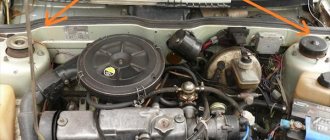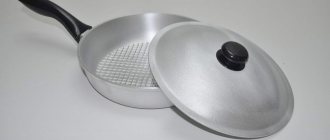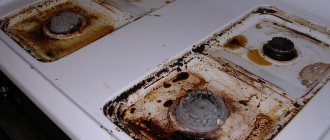Cleaning valves from carbon deposits without disassembling them is a problem that every car enthusiast will inevitably have to face. The formation of carbon deposits is a completely natural phenomenon during the operation of a car, but with the low quality of domestic fuel, it occurs much faster and can become a very unpleasant problem. Many car owners are put off by labor-intensive engine maintenance procedures. Therefore, they often wonder whether it is possible to clean the valves from carbon deposits without disassembling them.
Engine valve cleaning additives
The design of a modern engine begins with the combustion chamber.
Such important indicators as the power and efficiency of the system depend on its form and organization of the gas exchange and purging process. Valves are part of the combustion chamber, and their condition directly affects engine performance. Back in the 90s, BMW conducted research on the effect of engine valve contamination on power and identified the mileage at which the indicator could drop to critical values. It was found that over a run of about 10 thousand kilometers, pollution from low-quality fuel can reduce engine power by 30%, and a run on the Moscow-St. Petersburg route is equivalent in terms of the accumulation of pollution to 10 thousand kilometers across Europe.
Since then, fuel quality has improved significantly, but despite this, the problem of valve contamination continues to be relevant. The reason is the design of the motor. In most engines, fuel is injected directly onto a heated valve. This design is called MPI. The valve plate is always very hot, as a result of which the fuel does not have time to completely evaporate and begins to coke on the surface of the valve. Over time, the layer of coke continues to increase and this process occurs until it fills most of the area of the air channel. The engine begins to lack air, as a result of which power decreases and fuel consumption increases. To stop this process, effective means have been specially created in the form of cleaning additives for valves in gasoline, which are added to the fuel by large oil refineries.
But in urban driving, with traffic jams, long warm-ups and short runs, there are no conditions for the reliable operation of a small amount of additives already added to the fuel. Therefore, the question arises about cleaning engine valves.
For this purpose, additional additives are used that allow you to effectively clean the valves. Liqui Moly GmbH offers a wide range of fuel additives, including a valve cleaner item - Ventil Sauber. Let's take a closer look at its action.
Carbon deposits on valves are particles of pure carbon, glued together with resinous substances that are formed during partial combustion of fuel. Valve cleaning additive dissolves the resin, releasing small carbon particles. Thus, due to the active action of combustion catalysts, the product ensures complete combustion of both carbon and resin residues. A single fill of Ventil Sauber into a fuel tank containing 40-70 liters of fuel is enough to completely clean the valves, restore engine power and reduce fuel consumption to the values declared by the manufacturer.
Preventive measures
It will be useful for many car enthusiasts to know what measures need to be taken in order to minimize the time after which carbon deposits appear on the valves. In fact, such recommendations exist and they are quite simple. But here it is important to understand that preventive measures are relevant only for engines with direct fuel injection. For distributed injection, prevention is practically useless, since the rate of plaque formation there is already negligible. And so, for prevention it is necessary:
- Refuel with high-quality fuel . In particular, fuel without sulfur or other harmful chemical elements (or with an acceptable small amount of them). As mentioned above, when the air-fuel mixture burns, there is a risk that these elements will remain as carbon deposits on the timing elements, including the valves. Modern domestic manufacturers of automobile fuel often abuse the amount of additives in it, which are designed to increase the octane number of gasoline. However, often such additives during combustion form a large amount of soot, which is deposited, including on the valves.
- Regularly refill with high-quality oil . This requirement is indirect in relation to carbon deposits on the valves. However, if, in the event of damage to the valve stem seals or other malfunctions, low-quality oil (with impurities, solid mechanical elements in its composition) gets onto the valve walls, then there is a risk of it becoming coked and turning into carbon deposits. There are so-called low-ash oils, which, as the name implies, contain a small amount of chemical elements that form ash upon combustion. However, such oils are not suitable for all engines! Accordingly, they should be used only in those power units that are designed for appropriate lubricants (in particular, modern internal combustion engines that meet strict environmental standards). Additional information about which oils can be used in a particular car can be found in its manual or technical documentation. In general, it is necessary to change the engine oil at the frequency specified by the car manufacturer (or even more often). If for some reason you have used low-quality or unsuitable engine oil, then it makes sense to flush its oil system before filling in a new lubricant.
- Regularly check for carbon deposits on the valves . Without dismantling the intake manifold, this can be done using an electronic endoscope for a smartphone. This device is a miniature camera with a diameter of about 4...10 mm (there are different options, both larger and smaller), connected to a smartphone via a long flexible cable. It allows you to see the internal surface of various components in a car engine, for example, the presence of carbon deposits on the valves, the condition of the cylinder walls, the condition of the internal walls of the gas tank, and so on. Checking with an endoscope for the presence of carbon deposits must be performed approximately every 80...100 thousand kilometers. Or even more often, especially if the symptoms of this malfunction listed above are present.
- Change fuel and oil filters regularly . They to some extent help to retain chemical elements in their bodies, which subsequently turn into soot or soot. It also makes sense to monitor the condition of the engine cooling system so that the engine oil does not thicken too much and has normal pumpability and filterability.
There is another highly controversial piece of advice regarding how to prevent the formation of carbon deposits on the valves of an internal combustion engine. Its meaning is to periodically drive the car at high speeds and high engine temperatures. This extreme mode will allow you to get rid of some of the soot simply by burning it out. However, there are a number of subtleties here. The first is that this can be done on cars with engines with distributed injection. For direct injection, this approach makes no sense. The second subtlety is that this is truly a preventive measure, and it can only help at the initial stage, when the amount of carbon deposits on the valve body is small. If this amount is significant, then extreme driving mode will not help in this case, and other measures must be used to remove carbon deposits.
Conclusion
Soot on valves is a rather unpleasant phenomenon that can lead to the failure of important and expensive components of a car engine. Regardless of the type and design of the motor, carbon deposits still appear on all valves over time. It's just a matter of time and mileage of the car. However, engines with direct fuel injection (GDI) are most susceptible to this phenomenon. Therefore, it is necessary to periodically check for the presence of carbon deposits and, if possible, remove them. It also makes sense to periodically use special additives, whose task is precisely to clean the valves. However, it makes sense to use them specifically to prevent the appearance of soot, and not to remove it. In particularly “neglected” cases, cleaning carbon deposits is possible only at car service stations.
Cleaning valves on direct injection engines
But with cleaning valves on engines with direct injection, such as GDI, FSI, 4D and similar, everything is much more complicated. It may seem to many that the design features of the system eliminate this problem, but in reality this is not the case. And carbon deposits still form on the valves of engines with direct injection. The process happens more slowly, but it still happens.
Carbon deposits are caused by the presence of the EGR system. To improve environmental performance, a special EGR valve sends part of the exhaust gases with soot particles and unburned fuel back into the intake manifold, from where it then reaches the valves. According to statistics, over 80-120 thousand kilometers, a critical amount of carbon deposits on the intake valves, which is much denser and harder in structure compared to the carbon deposits of conventional engines. Therefore, it is not affected by fuel valve cleaning additives.
Most official services offer customers mechanical cleaning with removal and disassembly of the cylinder head of the engine valves. The process has two key disadvantages: the high cost of such cleaning and the significant time required to complete it. But there is an alternative.
To clean the valves, cleaning liquid is fed dropwise into the intake manifold. To do this, use a thin hose and a needle from a syringe. While the engine is idling, drops of cleaner fall on the intake valves and gradually clean them. Within 30 minutes of engine operation, critical deposits are eliminated.
But to implement this technology in a garage environment, you must have special knowledge. MTX Vergaser Reiniger carburetor cleaner is used as a cleaning agent. Determining where the cleaning fluid is supplied in the system also often requires specialized knowledge of the engine valve cleaning process.
To give the engine a “second wind”, you just need to properly clean the valves. On MPI engines it is recommended to clean them at least once every 2000 kilometers. This is especially true for urban conditions and the winter season.
Source
Cleaning the combustion chamber
There are many ways to clean the combustion chamber. The most time-consuming and expensive method is decoking with the engine head removed. In this case, all parts are cleaned mechanically. However, this process is very labor-intensive and therefore expensive. The cost of such an operation, in addition, increases the need to replace the intake manifold and cylinder head gaskets. Fortunately, recently it is possible to clean the engine much cheaper and faster.
Prevention significantly extends the life of rings and valves. Industrial enterprises produce a cleaning liquid that drivers add to gasoline when refueling. The norm is indicated in the instructions. There are liquid products for removing carbon deposits without disassembling the engine. The process looks like this:
- Warm up the engine.
- Set the pistons to the middle position.
- Turn out the spark plugs.
- Pour in carbon remover.
- Reinstall the spark plugs.
- Leave for a day.
- Remove the spark plugs and blow out the cylinders using the starter.
- Close the spark plugs and start the engine.
- After the procedure, change the oil.
Clean the valves from carbon deposits without disassembling the engine
Valve contamination problems
Drivers usually do not attach importance to the cleanliness of injectors and valves. They remember them when the car has already begun to twitch during acceleration. It is obvious that there are clearly problems with the engine. Even the best motor and its parts become clogged with dirt over time. Including intake valves. How to clean engine valves from carbon deposits without disassembling them?
Dirt on the valves can cause serious problems. Even after short periods of downtime, it prevents the valves from working. So-called sticking occurs. This causes misfires. After a couple of minutes, the valve naturally releases and continues to function. But the dirt doesn't go anywhere. Therefore the problem does not go away. And when restarted, the symptoms repeat.
In addition, debris accumulates inside the nozzles. Then “ragged” engine operation cannot be avoided. It's bad if the injectors are very clogged. They begin not to spray fuel into the cylinders, but literally pour it. This starts detonation. Which can lead to burnout of the pistons and major repairs of the unit.
How to remove deposits from the engine
What if you don’t drive a car for a long time? Let's say three or four months? Oxidation processes may begin in the engine. And the dirt will literally “weld” the valves to the seats. Then the starter simply will not turn the engine crankshaft. You will have to disassemble it and clean the accumulated deposits. And clean the valves from carbon deposits.
What causes deposits to form? Often the main reason is saving on fuel. Low-quality gasoline releases additives at high temperatures. They settle as dirt and clog valves and injector nozzles. To reduce contamination, you need to flush the engine regularly. It is recommended to do this after 60,000 km. Why use an ultrasonic cleaning stand?
Therefore, if you drive often and a lot, clean the injectors regularly. And also pour special additives into the tank. This will allow you to clean the valves from carbon deposits without disassembling the engine. Let's say you plan to park your car for a long time. Then fill the tank with auto chemicals and drive 20-30 kilometers with it. This will clean the engine of dirt. And the valves will not turn sour after a long period of parking. True, not every additive can be used. After all, many of them develop dependence on the motor.
A product for removing carbon deposits and deposits from cylinder head valves and pistons.
Hi all. We are disassembling the engine (102.963) and as work progresses there is a need to clean the cylinder head with valves and pistons from carbon deposits and resinous deposits. What is the best way to remove it? I’m asking because this is the first time I’m disassembling and assembling the engine myself. The information on the Internet from ammonia to carb cleaners did not bring any clarity. What do you think?
Installed January 5.1 instead of KE. A great weight off one's mind. I've been driving and smiling for 42,000 t.km. There are finally no problems. Maybe it's boring back?
Moscow 903-5237352 2010231f123541 190 carb175 white/blue interior 85g 1240281b958502 280e silver/velor 93g not E 1. I'm looking for blue rep mats (shaggy stripes) for 201, or large ones for 126-140 + any color for 2 01 with the preserved pattern form. 2. I’ll buy an expensive, excellent black pimpled steering wheel, right, from the link https://photo.qip.ru/. rzzzz/95256210/ 3. I am looking for an M104 block with the _closest_ number to number 1049хх 12 014198
I RARELY SELL ANYTHING, I DO NOT WRITE IN PM, CONTACT US THROUGH PHONE!
Thank you. Tomorrow we'll try solvent 646
Installed January 5.1 instead of KE. A great weight off one's mind. I've been driving and smiling for 42,000 t.km. There are finally no problems. Maybe it's boring back?
Thank you. Tomorrow we'll try solvent 646
Thank you. Tomorrow we'll try solvent 646
They say to soak a towel in 646 and cover it for a couple of hours. Then wet it again and wait a couple more hours. It seems to be scraped off. then clean it with kerosene.
Installed January 5.1 instead of KE. A great weight off one's mind. I've been driving and smiling for 42,000 t.km. There are finally no problems. Maybe it's boring back?
They say to soak a towel in 646 and cover it for a couple of hours. Then wet it again and wait a couple more hours. It seems to be scraped off. then clean it with kerosene.
If something is complex, then add oil after initial cleaning. Piston as a sample.
Attached images
E280.124th. manual transmission 1993 engine 103. silver metallic. Favorite bibika. E300.124th. automatic transmission 1993 engine 103rd. firmik! Dark green on velor. Bibika for my wife, and a toy for me.
If something is complex, then add oil after initial cleaning. Piston as a sample.
A toothbrush, a gas stove cleaner with a fat splitter, then rinse off with plain water. It can be cleaned in 2-3 times, the result is no worse than with acetone and is cheaper.
The oil will wash away anything, even waste. solvent varnish
Moscow 903-5237352 2010231f123541 190 carb175 white/blue interior 85g 1240281b958502 280e silver/velor 93g not E 1. I'm looking for blue rep mats (shaggy stripes) for 201, or large ones for 126-140 + any color for 2 01 with the preserved pattern form. 2. I’ll buy an expensive, excellent black pimpled steering wheel, right, from the link https://photo.qip.ru/. rzzzz/95256210/ 3. I am looking for an M104 block with the _closest_ number to number 1049хх 12 014198
I RARELY SELL ANYTHING, I DO NOT WRITE IN PM, CONTACT US THROUGH PHONE!
I ended up getting something like this. Thing.
W124 260E 103.940 1988 wdb1240231A779166
Repair of aircraft and motorcycle engines.
E280.124th. manual transmission 1993 engine 103. silver metallic. Favorite bibika. E300.124th. automatic transmission 1993 engine 103rd. firmik! Dark green on velor. Bibika for my wife, and a toy for me.
I always wash with a brush and undiluted contactless washing concentrate. You wash it off and the details become like pearls. The only thing is that if there are specific pieces of resin there, he won’t take them.
I always wash with a brush and undiluted contactless washing concentrate. You wash it off and the details become like pearls. The only thing is that if there are specific pieces of resin there, he won’t take them.
I ended up getting something like this. Thing.
It’s called “Automatic washing of parts and assemblies”, oddly enough =) I have a TS-600 model, a new one costs about 60 rubles, I bought a used one for 20.
W124 260E 103.940 1988 wdb1240231A779166
Valve cleaner
Valve cleaner must be used periodically to remove carbon deposits from their surface. You can remove it in two ways - with or without dismantling. In the first case, it is necessary to disassemble the engine, which is not always possible, and is simply labor-intensive.
Therefore, most modern car enthusiasts use special valve cleaning products. They are divided into two types - foam and liquid. Foam ones are intended for physical cleaning of the surface, while liquid ones need to be added to gasoline. The following material presents a rating of the most popular means of cleaning valves from carbon deposits, compiled on the basis of reviews and feedback from car enthusiasts.
| Valve Cleaner | Short description | Package volume, ml | Price as of summer 2022, Russian rubles |
| Liqui Moly additive for cleaning valves Ventil Sauber | The valve cleaning liquid that is poured into the tank is therefore a complex additive also for preventive cleaning of the power system and piston rings. | 250 | 500 |
| HI-GEAR Valve and Power System Cleaner | After use, it reduces fuel consumption by approximately 5.7%. | 295; 325 | 550; 600 |
| Valve cleaner Lavr | Effectively cleans not only valves, but also piston rings. Low price with high efficiency. | 310 | 250 |
| Foam decarbonizer “Valera” | A universal product that can be used to clean various engine parts and vehicle exhaust systems. | 210; 400 | 560; 750 |
| Wurth Foam Valve Cleaner | The most popular foam cleaner for intake valves. | 300 | 450 |
Experiment: removing carbon deposits from parts by boiling with washing powder. Video.
There is a garage legend that you can remove carbon deposits from engine parts simply by boiling them in ordinary water with washing powder.
I check it using the example of the cylinder head of the 164FML (CG200) engine from Stels Flame. You can also boil it in citric acid))))))
Fedotov, and soak in vinegar essence!
In fact, the problem is far-fetched: there is no point in removing carbon deposits from the combustion chamber. There is a point in cleaning the piston from coke, but that’s where acetone rules.
Kostello_irq, it makes sense if there is carbon deposits on the valves and seats. If you do not remove carbon deposits from the valves, they will not cool well. If you don't remove the carbon deposits from the saddles, they will burn out.
I washed mine too, but in a different way, because this Nika-4 is not sold everywhere. In Komus, 1 liter costs only 270 rubles, but pick-up costs only 300 rubles, and I don’t need 5 liters of concentrate (the asking price is about 1000 rubles). I used AVS foam engine cleaner and a toothbrush and then just polished the valves.
Kostello_irq, purely theoretically, citric acid should not damage aluminum. But in fact, after boiling in citric acid, the pistons don’t last long. Obviously because it is not pure aluminum, but an alloy.
Cyrix, thanks for the advice. Now the valves have been lying in acetone in the garage for a week, we need to take a look, I think they can already be scrubbed.
And about carbon deposits that interfere with cooling. Yes, but carbon formation is a continuous process and after ten engine hours everything will return to normal. Yes, and carbon deposits tend to burn out.
The piston in the photo traveled 86 thousand kilometers before it was removed. And they climbed into the piston only because the oil began to burn and the compression dropped. It turned out that the rings had run out.
We also recently tinkered with a WR450F (for a moment, this is a sports bike with engine hour service), and its piston generally shone like a mirror. It really is injected.
Source
Reasons for the formation of carbon deposits on valves
There are four main reasons why carbon deposits form on valve surfaces. Among them:
- Poor quality fuel . Unfortunately, in current conditions, gasoline or diesel fuel with various additives and that does not meet the proper specifications is often found at gas stations. During combustion, they form tar deposits on the valves. This also includes the use of low-quality and simply harmful fuel additives, which some motorists abuse.
- Wear of oil seals . The result of such a malfunction is oil on the valves. Carbon deposits from burnt engine oil settle on the surface of the valve and simply burn there.
- EGR system . Its main function is to burn exhaust gases. However, due to the design features of such motors, it is necessary to take into account that machines equipped with such elements are more susceptible to the formation of carbon deposits on the valves. This is why car owners often turn off the USR, but it is better to simply monitor the state of the system than to remove it.
- Natural process . Over time, carbon deposits form on the valves due to natural causes. Accordingly, with a high mileage of the car, especially if several different motor oils were used, then the formation of carbon deposits is inevitable. However, it is necessary to understand that it is impossible to bring it to a critical state and regularly use combustion chamber and valve cleaners.
Advice from experienced drivers
As a result of trial and error, obtained by car enthusiasts when cleaning a car engine, cheap and effective technologies were revealed. Drivers try to flush the combustion chamber with liquid without removing the cylinder head. The composition of the liquid that dissolves dirt was obtained experimentally. Its composition consists of hydrocarbons capable of softening charred oil impurities:
- kerosene;
- turpentine;
- oil.
Take the components in equal quantities, usually 0.5 liters each. Pour the mixture into the cylinders overnight. After washing, change the oil.
How is soot harmful?
Carbon deposits on the valves of an internal combustion engine reduce the performance characteristics of the engine and its overall service life. When the valves become clogged, the cross-section of the air channels decreases, that is, the engine “suffocates.” In turn, this can lead to failure of the gas distribution mechanism.
Externally, this leads to the following consequences:
- Floating engine speed . Moreover, this can be observed in a variety of modes of its operation - at idle, hot, cold. If the valves are significantly clogged, the engine may simply stall, especially if it operates at low speeds.
- Jerking while driving . The car either randomly accelerates or, on the contrary, slows down. This situation is not only unpleasant, but also downright dangerous, especially when driving in heavy traffic. Cold starting problems may occur.
- Loss of power . The car accelerates poorly and does not pull.
- Increased oil consumption . There may also be excessive blue smoke from the engine.
- Valve burnout . In turn, this leads to the fact that the cylinder in which the valve froze or burned out essentially stops working. The car will “triple”
- Deterioration of engine cooling . This occurs due to the fact that carbon deposits have low thermal conductivity, so heat from the engine dissolves less well in space. In turn, an ineffective engine cooling system reduces its overall resource. Detonation may occur.
Therefore, valve cleaning without disassembly, using additives, must be carried out regularly after every 3rd oil change . As for foam valve cleaners, they are used half as often. In general, it is recommended to check the valves themselves every 80...100 thousand kilometers . Each car owner decides for himself which product is best to use for this, but in general it all comes down to using one of the five TOP ones.
How to check valve tightness
If a large amount of carbon deposits have been detected on the valves, then, among other things, it makes sense to check their tightness. It also makes sense to do this after a major overhaul of the engine, as well as after grinding in the valves. To do this, it is necessary to dismantle the entire cylinder head in order to ensure normal access to the valves. In addition, it is necessary to dismantle the camshaft and the rocker arm axles must also be removed. This will ensure that all valves are closed. It is also necessary to dismantle the inlet and outlet manifolds to provide access to their wells. There are two ways to check - one is not entirely correct, and the second is more complete and correct.
Checking valves for leaks, method one
The head should be placed on its side so that the holes of the wells where the mentioned collectors are connected are directed upwards. Accordingly, the valves will be in a horizontal plane. Next, you need to pour gasoline into these holes one by one (and kerosene is best, it leaks better), and make sure that it does not leak out from under the valves. This is the key to valve tightness. If gasoline oozes out, it means the valve needs to be repaired (grinded in). In this case, it is necessary to dry the valve outlets using a compressor (gun) in order to ensure the appearance of gasoline at the valve outlet. However, this method is not able to detect gas leakage under load. In addition, this verification method is difficult for engines equipped with an EGR system. Usually there is a special valve on one or more cylinders through which gasoline will simply pour out of the well.
Diagnostics of a tight valve fit, method two
The cylinder head must be positioned “upside down”, that is, so that the valve outlets are on top and the manifold well openings are on the sides. Next, you need to pour a small amount of gasoline into the valve outlet cavity. Next, use a compressor to supply a stream of compressed air into the side well. Moreover, it is fed into the openings of both the intake and exhaust manifolds. If the valves are sealed, then under such a load air will not leak from under them. And accordingly, if the tightness is broken, then a certain amount of air will seep into the gasoline from under the valve, which will be visually visible from the bubbles that are directed upward in the gasoline. This method is very effective and makes it easy to diagnose the corresponding breakdown.
Valve cleaner ratings
The list of the most popular and effective valve cleaners at the moment consists of 5 products, created on the basis of reviews and reviews found on the Internet. Most of them are used not only to remove carbon deposits on valves, but also to clean piston rings and the power system because deposits settle on all parts of the combustion chamber.
Liqui Moly Ventil Sauber
The Liqui Moly Ventil Sauber valve cleaning additive is one of the most popular such products. This is due to its extreme efficiency. It is a liquid that is added to fuel. It not only removes carbon deposits on valves, but also removes deposits in the power system, injectors, carburetor and intake tract elements. In addition, it prevents the formation of corrosion on metal surfaces, both liquid and electrolytic. Liquid Moly valve cleaner can be used on any type of engine, including those equipped with catalysts and turbocharging.
Reviews of the Liqui Moly Ventil Sauber 1989 valve cleaner are mostly positive. Most car enthusiasts who have used Liquid Moly to clean valves note its high effectiveness. In particular, many write that even quite deep deposits are removed from the surface of the valves, including those formed when using low-quality fuel. Accordingly, engine power increases, and the clicking sounds made by the valves go away. Thus, the cleaner definitely deserves a leading position in the ranking.
The only drawback is the price is a little high compared to its competitors. You can buy the additive in a 250 ml can, which is enough to dissolve in 75 liters of fuel. If the volume of the car tank is smaller, then the product must be poured in proportion. The price of one package as of summer 2020 is about 500 rubles.
HI-GEAR FUEL SYSTEM & VALVES CLEANER
HI-GEAR FUEL SYSTEM & VALVES CLEANER valve cleaner is designed for use with any type of gasoline engine up to 2.5 liters. Including engines equipped with catalysts and turbines. The manufacturer directly states that this product is recommended for preventive use every three thousand kilometers. The additive is poured into the fuel tank, so it also has a positive effect on the power system. The original detergent element included in the product is TFS23. Stops rusting and also reduces fuel consumption by 5...7%.
The HI-GEAR valve cleaner is highly effective. It efficiently and quickly removes not only carbon deposits from valves, but also cleans pistons, as well as elements of the fuel system. Accordingly, there are mostly positive things about him. In rare cases, when the soot is already significant, it may not cope, but since the product is positioned as a preventative, there can be no corresponding claims against it. One of the disadvantages is the high consumption of the additive for a small volume of gasoline.
The High Gear valve cleaner is sold in metal bottles of two different volumes - 295 ml and 325 ml (items HG3235 and HG3236). The volume of the larger jar is enough to dissolve it in 40 liters of gasoline. The price of the smaller can as of the above period is about 550 rubles, and the larger one is about 600 rubles.
Valve cleaner Lavr
Valve and combustion chamber cleaner “Lavr” Ln2134 is the third most popular liquid cleaner among car enthusiasts. Reviews from car owners indicate that it very quickly and efficiently washes not only carbon deposits on valves, but also dirt on other elements, in particular on rings.
Can be used on any gasoline engines, including those with catalysts and turbines. Its use is standard, that is, it must be poured into the fuel tank immediately before refueling, where you then add gasoline and drive until it is empty. The composition contains: a base aliphatic solvent, a package of proprietary detergent additives, aliphatic alcohol and functional active substances.
Valve cleaner “Lavr” increases the power characteristics of the engine, reduces fuel consumption, and reduces the toxicity of exhaust gases. Reviews about the product are mostly positive. There are positive changes in the cleanliness of pistons and valves. So, there is a 310 ml jar on sale, the price of which is about 250 rubles. One jar is enough for 40...60 liters of gasoline.
Foam decarbonizer “Valera”
A domestic product, the Valera foam decarbonizer from VMPAvto 8507, is also very popular for cleaning valves. The product is positioned by the manufacturer as a universal product designed for cleaning engine parts during disassembly, including valves and rings. It effectively removes deposits and dirt.
Foam must be applied to the surface to be treated. After this, leave the foam for 5.7 minutes to perform a chemical reaction so that the carbon deposits dissolve. It is recommended to perform this cycle up to 3.5 times depending on the complexity. The foam must be removed using a syringe, then blow off the surface with compressed air. Therefore, the product will have to be used when partially dismantling some elements or when disassembling the engine.
The “Valera” decarbonizer is popular among both car service professionals and ordinary car enthusiasts, which confirms its effectiveness. To clean carbon deposits from valves or rings, up to 5 cycles are usually carried out. This is enough to remove even the most stubborn carbon deposits. It can be used to clean intake and exhaust manifolds, rings and other parts removed from the engine. Among the disadvantages, one can note only a fairly high price with a large consumption of funds.
Decoking “Valera” is sold in packages of two sizes. The first is 400 ml in volume (enough for processing parts of a 12-cylinder engine), its price is about 750 rubles. The second package volume is 210 ml, costing 580 rubles.
Wurth Foam Valve Cleaner
Valve cleaner "Vert" 0893033 is a foam cleaner, that is, it must be applied inside the intake manifold. According to the instructions, it is fed into the intake manifold on a warm engine running at 2 thousand rpm, in two passes with an interval of 30 minutes.
Wurth foam cleaner is used to remove carbon deposits and deposits in the intake manifold, valves and combustion chamber. Thanks to this complex action, the manufacturer promises to reduce fuel consumption, restore engine power, equalize compression and improve the operation of intake valves. Reviews about the product are mostly positive. It can be used to clean almost any gasoline engine. The disadvantage is that it is not convenient to use with all engines. In addition, the consumption of funds is quite large.
Use of nut shells
Frequent problems with the formation of carbon deposits in the combustion chamber of carburetor engines, especially direct fuel injection systems, have forced automotive specialists to develop technology for removing these deposits in an ergonomic and safe way.
The latest developments by scientists in the field of chemistry make it possible to clean carbon deposits without dismantling parts. European automotive service companies are introducing cleaning technology based on the use of special granules that safely remove deposits from intake ports and valves. A process has also been developed to neutralize the granules, which does not leave residues.
The new technology is developed on the principle of sandblasting, but not with sand, but with a soft abrasive material - walnut shells. The method is non-invasive and completely safe, while being 100% effective. After the operation, the valves are in perfect condition.
To effectively clean the intake channels and valves until they are completely free of deposits using the new technology, you do not need to open the engine head; it is enough to dismantle only the intake manifold. The high efficiency and short time required to complete this procedure is an excellent alternative to traditional methods of removing carbon deposits and disassembling the engine.
The technological process of cleaning with granules does not cause abrasion of the material, so the surface of the cylinder mirror is maintained in good condition. Benefits of carbon blasting:
- Effective removal of contaminants with a flow of granules.
- A special abrasive ensures stable cleaning quality.
- The specific, non-sharp geometry of the granules, as well as their internal structure, makes it possible to remove contaminants with high quality, while maintaining the surface of the parts.
- The neutralizer allows you to effectively remove slag residues after cleaning.
- The nozzles in the set are selected for various channel shapes.
How to flush the engine: oil compounds, cleaners and other chemicals
Carrying out a flush just because it was recommended by second-rate car repair shops is impractical and, at best, pointless, and at worst, it can cause serious engine damage. This procedure is important to carry out in the following cases:
In the first situation, when the new owner of the car does not know what kind of oil was used before, flushing is mandatory and is associated with the presence of additives in the lubricant. Such additives are not found in cheap and low-quality formulations; accordingly, they do not protect the engine from the formation of deposits.
If the engine oil is changed when switching from synthetics to mineral water or vice versa, then first fill in the flushing oil. This way they get rid of old additives: there is a high probability that they will completely leave the system and will not react with new ones.
Regularly flushing the engine of a new car helps avoid deposits on parts. If the car is used actively and in difficult conditions, then it is recommended to wash the engine even in passenger cars.
Engine requiring urgent flushing
Experts do not recommend flushing the engine only in two cases:
How to clean an engine: useful tips
How to wash an engine depends on the type of contamination: oil, fuel oil, internal or others. Instructions for each case are in our instructions.
The question of how to clean the engine of your own car will certainly arise for a car owner who is accustomed to doing independent maintenance of his car. Carrying out such a procedure is inevitable to preserve the functionality of the key power unit. Oil or other deposits sticking to the outer surface or inside contribute to disruption of thermoregulation, reduce performance and protective characteristics, and increase the risk of corrosion and other negative phenomena, including breakdown. To avoid such an unfavorable scenario, you will have to work hard to eliminate contamination.
Often, to rid the engine of contaminants, especially those that are thoroughly dried or ingrained, motorists use special installations that supply cleaning compounds under a certain pressure. It is highly undesirable to use this technique due to the increased likelihood of damage to wiring, gaskets, and other rather fragile elements.
Known solvents should be used with caution. Often, car owners use diesel fuel, kerosene or gasoline to answer the question of how to clean the engine. The first two options are acceptable in the absence of other solutions, but we must remember that after them, when the unit warms up, caustic fumes will begin to be released. Gasoline is not suitable due to the high risk of fire.
Before cleaning the engine, you need to do some preparation. The temperature readings of the power unit are brought to 50-60 degrees by cooling or idle heating. It is preferable to remove the battery from under the hood. Individual electrical or fragile components: air filter, distributor, terminals, other elements should be protected by wrapping them in a suitable amount of foil, tape or film.
When planning to clean the external elements of the motor, after purchasing the necessary product, you need to read the instructions supplied by the manufacturer, then follow the instructions from there. Usually it goes something like this. Contaminated surfaces are first slightly moistened with water. Then, if the question of how to wash engine oil from the engine was decided in favor of an aerosol, it is sprayed on problem areas.
You will have to rid the engine of oil that has burned from the inside. Such operations are usually not carried out when regularly replacing this technical fluid, although they will not hurt. Here you need compounds for internal flushing, of which well-known manufacturers, like LIQUI MOLY or Shell, produce quite a lot, and they are quite affordable.
If, when deciding how to clean the inside of an engine from carbon deposits, preference is given to fast-acting cleaners, it is worth considering Hi-Gear, the effect of which lasts only 10 minutes. Before carrying out such manipulations, it is necessary to drain the remaining oil from the system, after which the selected product is poured into it in the volume required according to the instructions. While the flushing oil is inside the engine, it is turned on at idle speed.
Finding the answer to the question of how to clean off oil deposits in an engine is much easier than finding a means to remove fuel oil contaminants, which are difficult to remove. Car enthusiasts often use gasoline or other solvents for such operations, but many of them promise an increased risk of fire the next time the unit is turned on, and they also demonstrate low efficiency.











